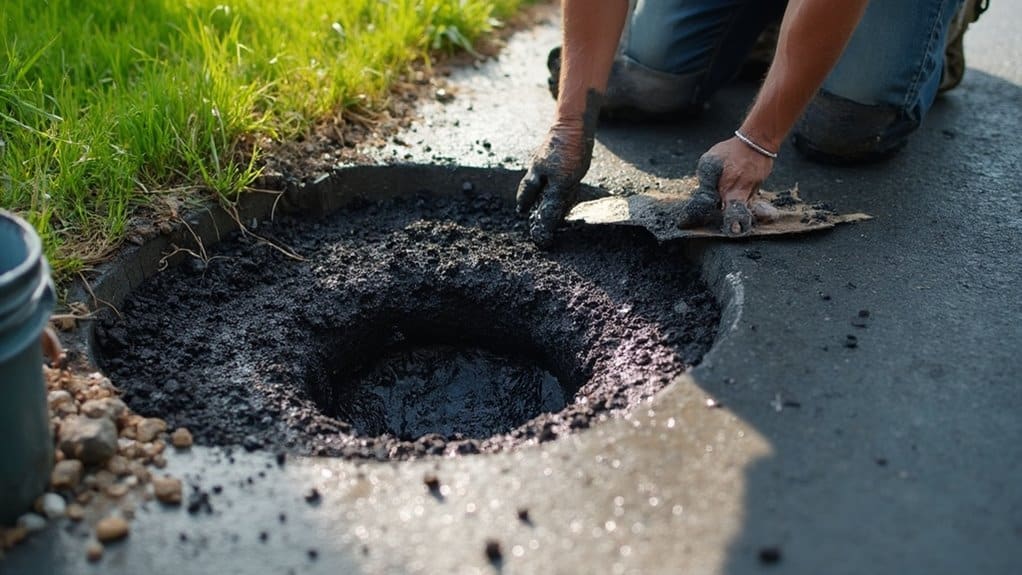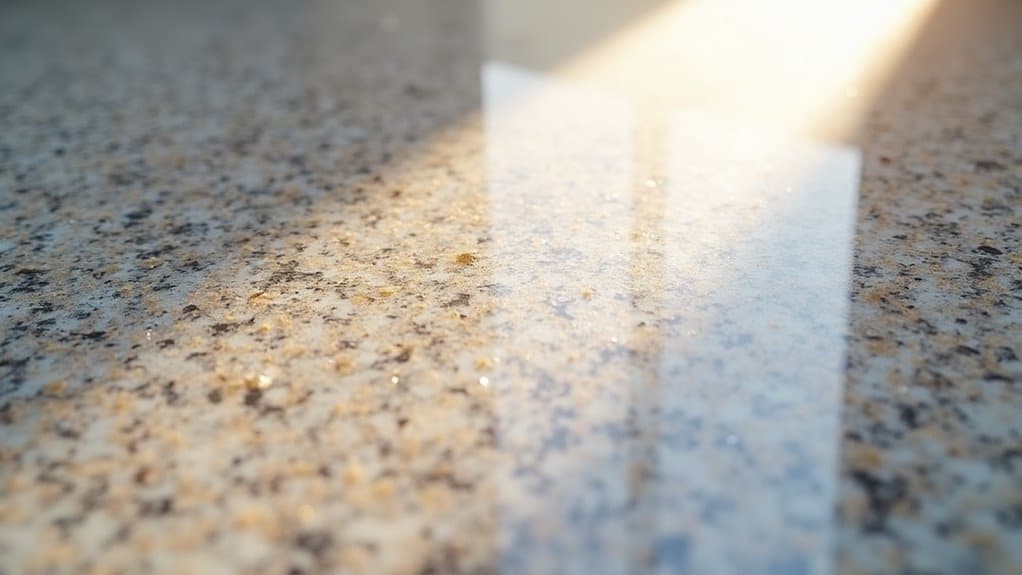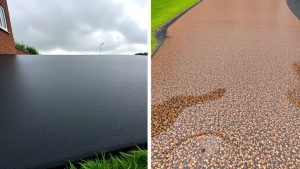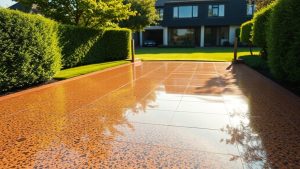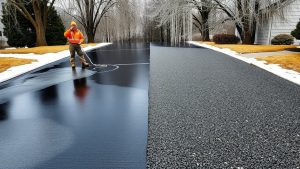To repair potholes and dips in your tarmac driveway, begin by assessing the damage and removing any debris. Select the right repair material: use Hot Mix Asphalt for a robust fix in warmer weather, or Cold Mix Asphalt if it's cooler. Dig out around the damaged area and compact the base to ensure stability. Layer the repair material, compacting it well after each layer. Allow it to cure properly, and ensure safety measures are in place throughout the process. For long-lasting results, conduct regular checks and adopt sustainable practices to extend your driveway's life. There are more methods available to ensure effective repairs.
Table of Contents
ToggleKey Takeaways
- Start by assessing the damage and clearing any debris to fully expose the pothole or dip.
- Select the right repair material depending on the weather, such as Hot Mix Asphalt for warm conditions or Cold Mix Asphalt for cooler weather.
- After digging out weak soil, make sure to compact the ground thoroughly and add gravel for stability.
- Use a jointing compound to blend the new repair seamlessly with the existing tarmac for a smooth finish.
- Regularly inspect and maintain your driveway to prevent future potholes and extend its lifespan.
Preparation and Planning for Repair
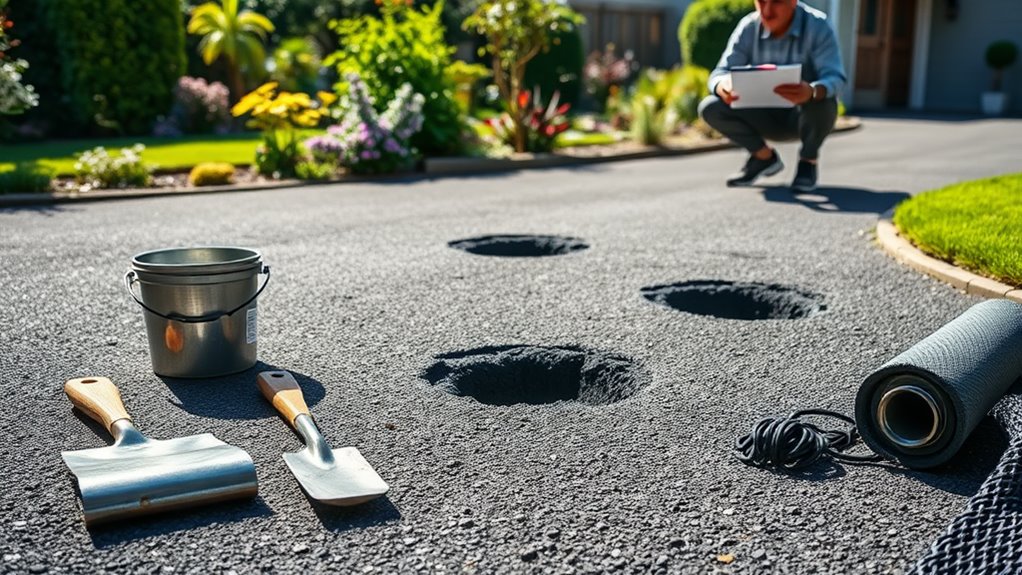
Before you start repairing potholes in your tarmac driveway, it's crucial to assess the damage first to prioritise your repairs effectively.
Begin with a thorough site inspection to gauge the extent of the damage. Check each pothole, noting their sizes and locations—this will help you decide if you can tackle the repairs yourself or if you need to call in a professional. Clear away any debris and vegetation to expose the damaged surface. Potholes cause damage to tires and cars, so it's essential to address them promptly. Additionally, ensure that you identify any signs of poor drainage that may have contributed to the potholes.
Next, create a repair schedule, considering the weather conditions for optimal adhesion.
Make sure to gather all the necessary tools and materials beforehand. Remember to wear appropriate safety gear, and ensure your work area is free from obstacles to maintain safety during the repair process.
Understanding Repair Materials
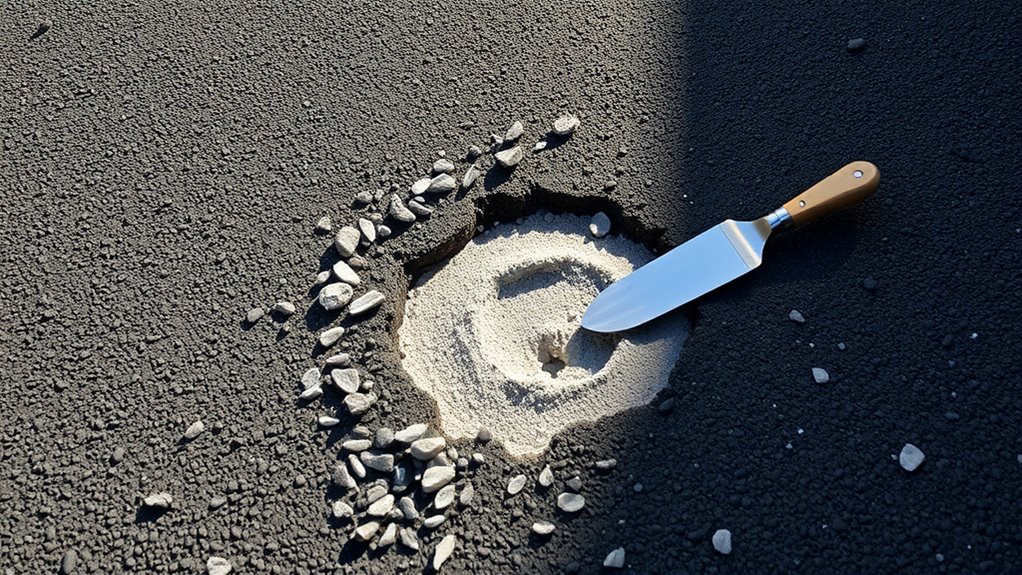
Evaluating the damage and preparing for repairs is essential for understanding the materials you'll use to fix potholes.
There are several types of repair materials, each with its own characteristics. Hot Mix Asphalt (HMA) is durable but requires special equipment. Cold Mix Asphalt (CMA) is better suited for colder weather.
For a more cost-effective option, consider Spray Emulsion and Aggregate, which can boost productivity. Proprietary mixes like FASTPATCH DPR are user-friendly and environmentally friendly, containing 80% recycled materials, which highlights their sustainability.
Additionally, options such as BOND-X GREEN allow for quick repairs using biodegradable binders.
Excavation and Base Preparation
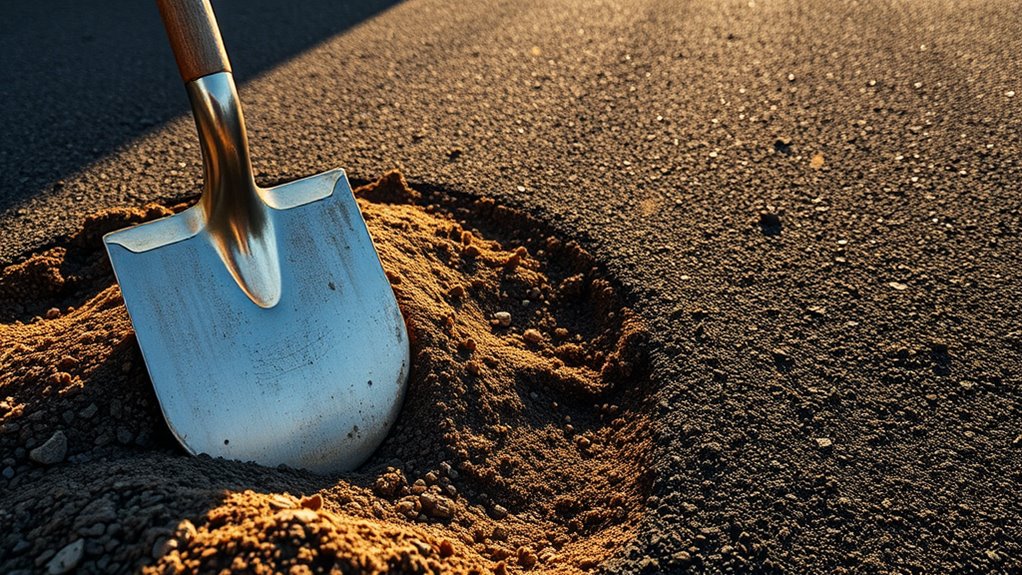
When repairing potholes in your tarmac driveway, proper excavation and base preparation are crucial for lasting results.
Begin by clearing loose debris and vegetation with a shovel or broom to ensure the area is tidy. If needed, use a petrol-powered saw to cut around the damaged sections.
Dig down to the subsoil to remove any weak soil that could lead to settling, compacting the ground with a tamper as you go. It is important to remove excavated material to prevent future settling under the surface. Implementing effective drainage solutions during this process can further enhance the durability of the repairs.
After that, lay down a layer of gravel or crushed stone, making sure it's level and compacted thoroughly with a roller or plate compactor for stability.
Check the subgrade for any issues, and use soil modifiers if necessary to create a strong, stable foundation for your repairs.
Applying Repair Materials
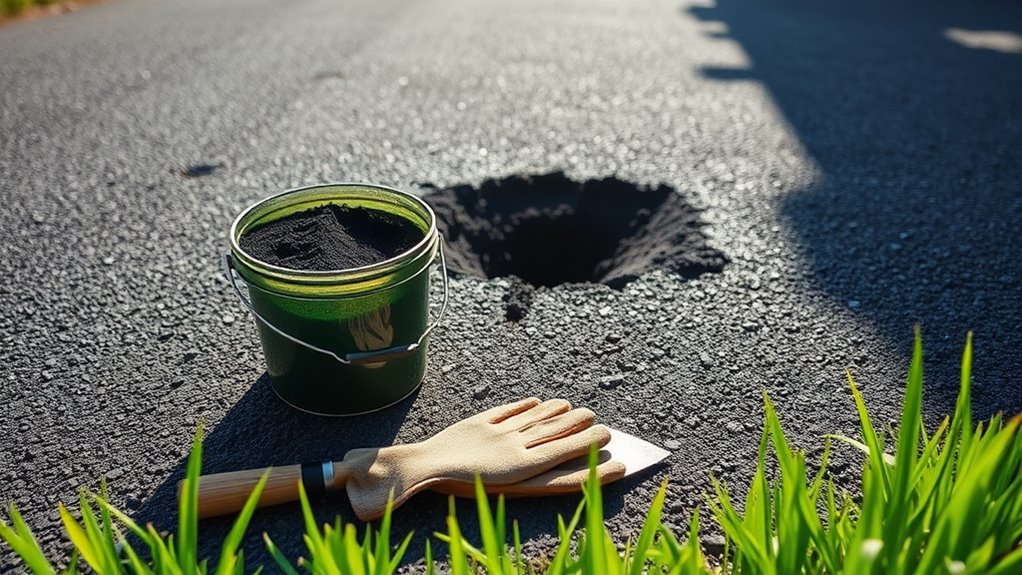
When applying repair materials, it's important to layer the tarmac properly for lasting results.
Begin by filling the deepest sections of the pothole, then add material in thinner layers, compacting each one securely.
Finally, use smoothing techniques to ensure a level surface that blends seamlessly with the existing driveway.
Layered Material Application
For a durable and effective repair of potholes in your tarmac driveway, it's crucial to apply materials in layers correctly.
Begin by filling small cracks with a crack repair compound, mixing it with water to create a paste. For larger potholes, use cold lay tarmac, ensuring you compact it well to restore the original surface level.
Use layered application techniques to seamlessly blend the new repairs with the existing tarmac using a jointing compound. Always clean the surface thoroughly beforehand, as any debris can affect adhesion.
Ideal weather conditions, like warm days, can enhance the effectiveness of your repair. Following these steps will ensure a long-lasting repair, preserving your driveway's structural integrity and appearance.
Surface Smoothing Techniques
Having successfully applied layered materials to repair the potholes, it's time to concentrate on surface smoothing techniques that ensure a seamless finish. Proper surface levelling is crucial for both durability and appearance. Use a tamper or plate compactor to achieve even compaction across the repaired area. After compacting, apply a tarmac patching compound, spreading it evenly with a trowel. Be sure to allow sufficient curing time before sealing. Regular inspections can help identify common issues that may arise after repairs, ensuring the longevity of your driveway.
| Technique | Description |
|---|---|
| Tamper | Compact the area to level it with surrounding surfaces. |
| Plate Compactor | Ideal for larger areas requiring more force. |
| Trowel Application | Spread patching compound evenly for a smooth finish. |
| Curing Time | Ensure full curing before applying sealant. |
| Regular Inspections | Check for new damage to maintain surface quality. |
Compaction and Curing Process
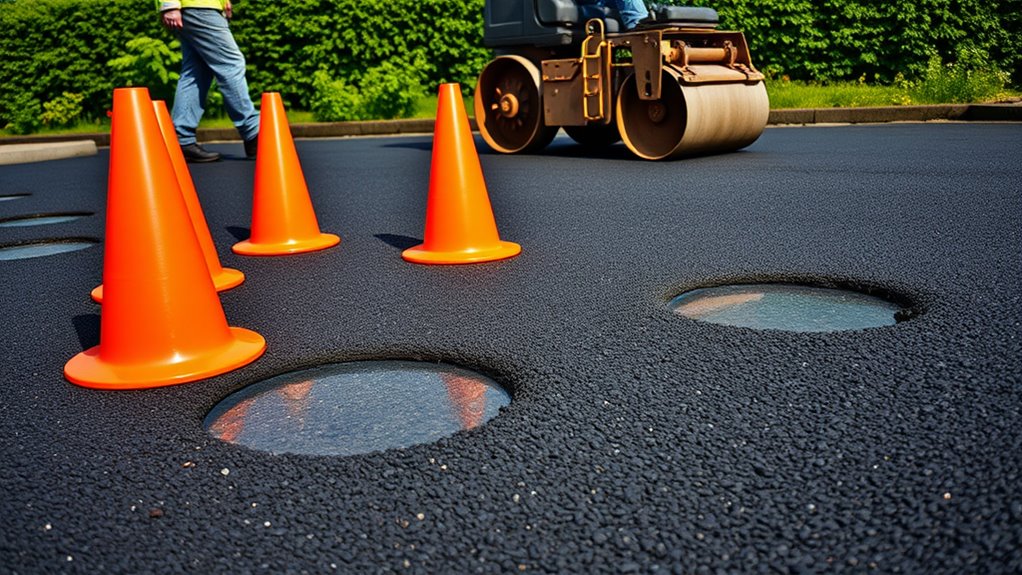
To successfully repair potholes in your tarmac driveway, proper compaction and curing processes are crucial.
For small areas, hand tools like a tamper or the plywood method work well. For larger patches, a gas-powered plate compactor is more effective. Ensure each layer of material is compacted evenly for consistent density.
After compacting, it's important to allow the patched area to cure for several days, following the manufacturer's guidelines. This step is essential to avoid future problems.
Don't apply sealant until the patch is completely dry; controlling moisture is key to prolonging the repair's lifespan. Regular inspections will help keep your driveway in good condition.
Maintenance and Safety Precautions
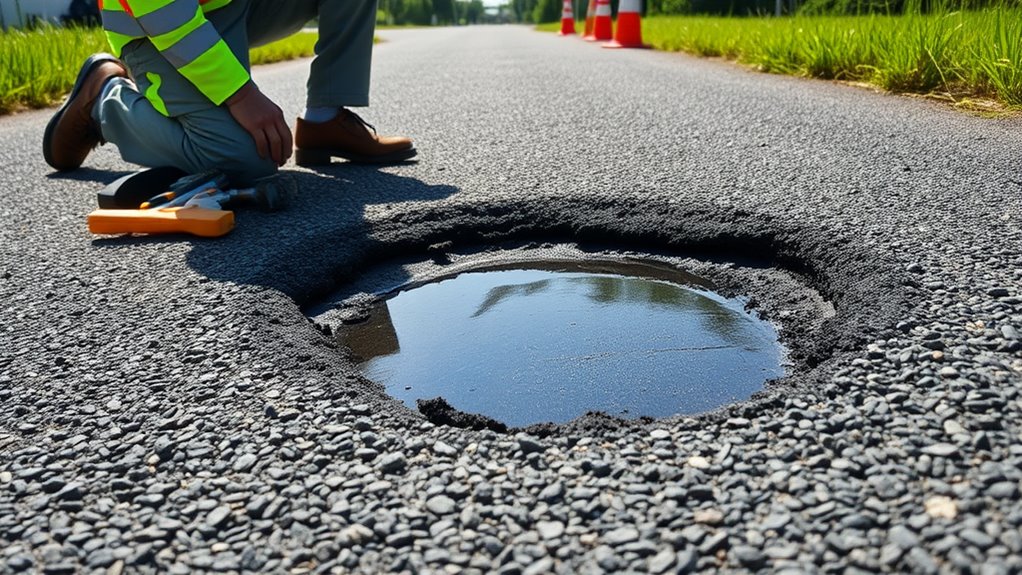
To keep your tarmac driveway in good condition, regularly check for cracks and potholes.
Wear protective gear like gloves and safety goggles when carrying out repairs to ensure your safety.
Routine Inspection Importance
Routine inspections are crucial for keeping your tarmac driveway safe and in good condition. By regularly checking for issues, you can catch potential problems early and make necessary repairs before they lead to costly damage.
Here are some key benefits of routine inspections:
- Hazard Identification: You can spot uneven surfaces or loose stones before they pose a risk to you or your vehicles.
- Structural Integrity: Regular checks help assess wear and tear, ensuring your driveway remains stable.
- Safety Enhancement: By addressing issues promptly, you reduce the likelihood of accidents or legal claims.
- Aesthetic Preservation: Keeping your driveway well-maintained not only enhances its appearance but also boosts your property's curb appeal.
In short, routine inspections help safeguard your investment and ensure your driveway remains in top shape.
Protective Gear Usage
Inspecting your tarmac driveway helps spot issues before they worsen, but wearing the right protective gear is equally important during repairs.
Always wear safety goggles to protect your eyes from debris and dust. Gloves are crucial for safeguarding your hands from rough surfaces and harsh chemicals. Steel-toe boots protect your feet from heavy objects, while a dust mask helps prevent inhalation of harmful particles.
If you're working in low light, a high-visibility jacket is essential. Always adhere to safety standards; ensure your tools are well-maintained and follow the manufacturer's guidelines for proper use.
Monitoring and Post-Repair Inspection
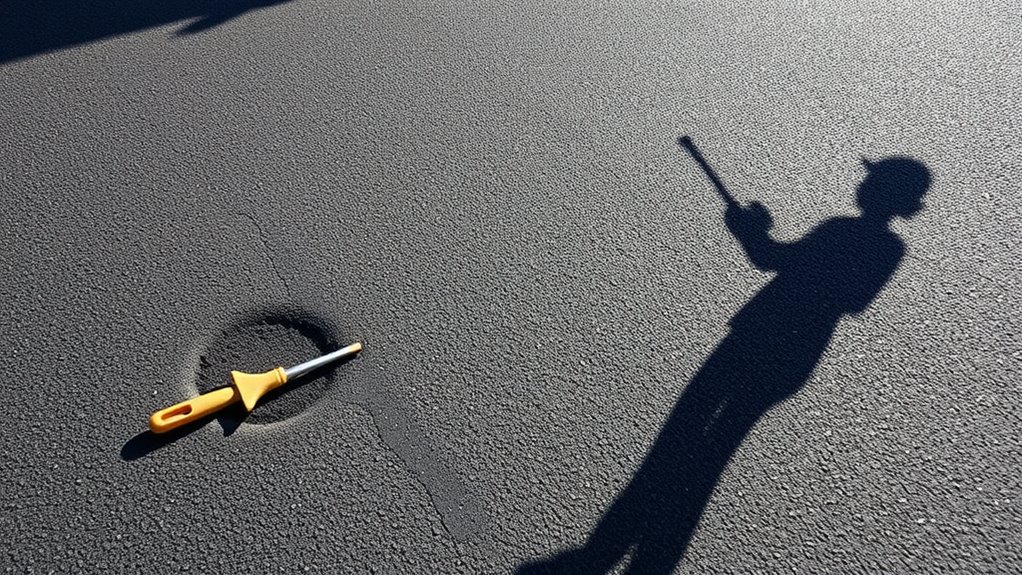
Monitoring and Post-Repair Inspection
After repairing your tarmac driveway, it's crucial to carry out a thorough inspection to ensure the repairs are effective and long-lasting.
Use various monitoring methods to assess the quality of your work and keep the driveway in good condition.
Follow this inspection schedule:
- Immediate Check: Inspect straight after the work is finished.
- Short-Term Follow-Up: Reassess a few weeks later.
- Seasonal Inspections: Check at the beginning of each season.
- Annual Review: Perform a detailed evaluation once a year.
Pay attention to key areas like surface smoothness, material compaction, sealer application, and overall durability.
Regular checks will help confirm that your repairs can withstand time and daily use, ensuring your driveway remains functional and visually appealing.
Preventative Measures for Longevity
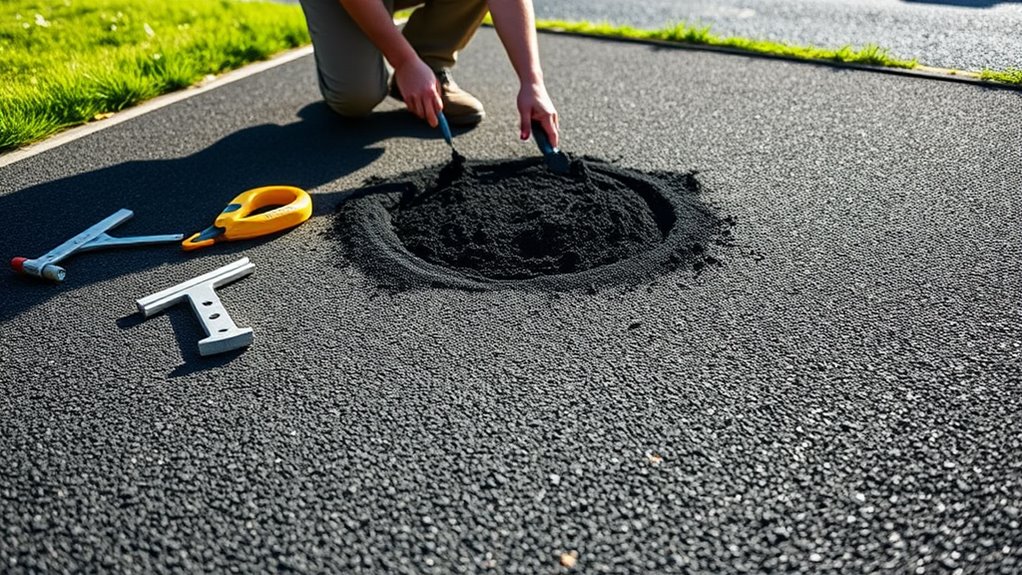
To ensure your tarmac driveway lasts, it's important to carry out regular maintenance.
Start with routine inspections to catch any problems early. Clean the surface regularly to prevent debris build-up, which can lead to damage. Use plywood under heavy vehicles to distribute weight evenly and avoid parking in the same spot repeatedly.
Sealcoating every 3-5 years is crucial for protecting against UV rays and water damage.
Make sure drainage is effective to minimise water pooling and erosion. Finally, keep vegetation under control to stop invasive plants from harming the surface.
Environmental Considerations in Repairs
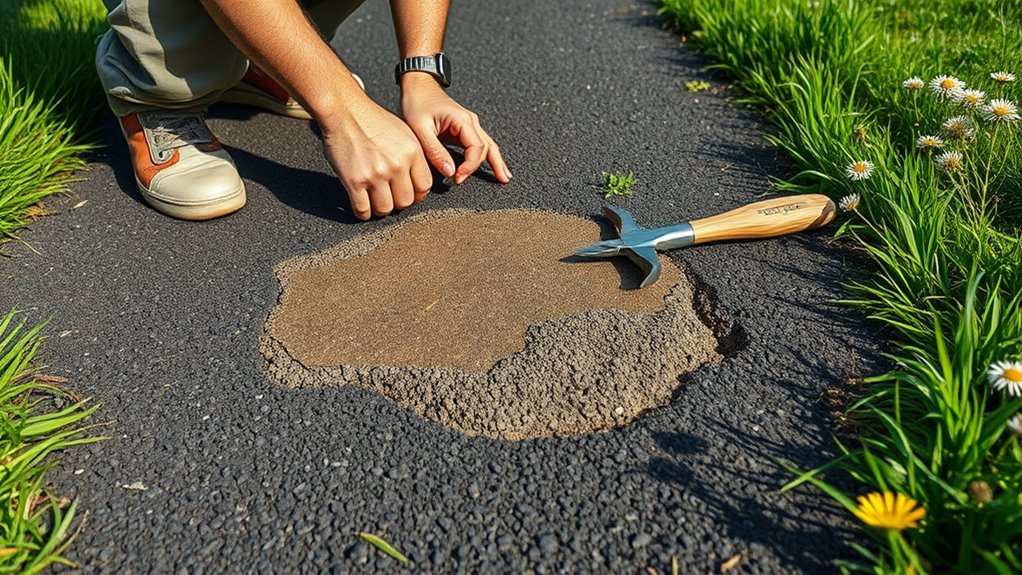
Regular maintenance of your tarmac driveway not only prolongs its lifespan but also helps reduce its environmental impact.
By implementing sustainable practices and using eco-friendly materials, you can lower resource consumption and waste during repairs. Here are some effective options:
- Permeable pavers or porous asphalt: These improve drainage and reduce surface water runoff.
- Recycled aggregates: Using these minimises the need for new materials and reduces landfill waste.
- Warm mix asphalt: This technique lowers emissions during the repair process.
- Biogenic asphalts: These alternatives help decrease carbon footprints.
Choosing these options not only enhances your driveway's durability but also supports local ecosystems and diminishes the urban heat island effect.
Frequently Asked Questions
How Long Does the Repair Process Typically Take?
The repair timeline depends on the size and severity of the damage. Minor repairs may take around 30 minutes, whereas more extensive work can last for hours, particularly if adverse weather affects the curing process significantly.
Can I Fix Potholes During Winter Months?
When winter hits, you can still repair potholes. Use cold mix asphalt for the job, but ensure temperatures are at least 3ºC and rising to effectively manage the challenges of the season.
What Are the Costs Associated With Pothole Repair?
When looking at pothole repair, costs can differ significantly depending on the method used. For instance, cold patch is a cheaper option but provides only a temporary fix. In contrast, hot mix is more expensive yet offers greater durability, making it a better long-term solution.
How Can I Identify the Best Repair Materials?
To identify the best repair materials, assess their durability in terms of weather resistance, load-bearing capacity, and ease of application. For instance, when repairing outdoor surfaces, consider materials that can withstand rain and frost. It's also wise to choose products that offer flexibility and sustainability, ensuring your repairs last and are environmentally friendly.
Will Repaired Areas Match the Existing Driveway Texture?
Achieving a perfect match between repaired areas and the existing driveway texture can be challenging. Advanced repair techniques, such as infrared methods, can help reduce noticeable differences, but complete uniformity might still be out of reach. For example, if your driveway has a specific pattern or finish, replicating that precisely in repairs often proves difficult.
Conclusion
Fixing potholes and dips in your tarmac driveway isn't just about aesthetics; it's about maintaining the integrity of your entrance. With the right tools and materials, you can achieve a smooth surface that lasts. Regular upkeep acts as a preventative measure against further damage, keeping your driveway looking its best. So, gather your materials, follow the steps, and give your driveway the care it deserves—it will enhance your home's appeal.
Prepare the perfect base for your resin bound stone installation and discover the crucial factors that ensure lasting durability.
Know where resin bound surfacing can transform spaces for both residential and commercial use, and discover the countless benefits that Read more
A stone carpet combines beauty and resilience in flooring, but what makes quartz floors uniquely beneficial? Discover the secrets behind Read more

